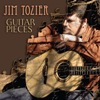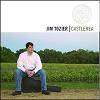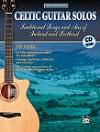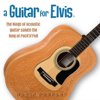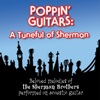| FAQ |
| Guitars and Gear |
A: Giving it to a good fingerstyle guitarist! Yes, I'm being funny... but there's a lot of truth in that, too. The guitar is a much smaller part of the equation than most people realize. For example, if I were to list my preferences for a "fingerstyle guitar," you'd end up with almost the exact opposite of the guitar that Michael Hedges used (a Martin D-28), and it would obviously be silly to suggest that he was using the wrong guitar! Ultimately, there's no "right" answer to what makes a good fingerstyle guitar. Q: What features/specifications do you look for when buying a fingerstyle guitar?
A: I've owned a fair number of guitars over the years (see my Guitar History page for a list), and that's allowed me to hone in on some particular features or specifications that I prefer for a fingerstyle guitar. Probably the two most important things I look for are a nut width of 1-3/4" (or wider), and a smaller-bodied guitar—something along the lines of a Martin OM in terms of size. After narrowing down the search to a small-bodied guitar with a 1-3/4" nut, the next feature I look for is a solid cedar top. While not essential, I definitely gravitate toward the sound of a cedar-topped guitar. The next things I'll look at are the scale length and the ratio on the tuners. I tend to prefer a longer scale length (25.5" or more) on a fingerstyle guitar, and I also like tuners with a gear ratio of 21:1 or 18:1. Of course, tuners can always be upgraded—but it's nice to have a good set of tuners as standard equipment. Although I've never actually owned a guitar with an armrest or a bevel built into the lower bout, I have played several that did—and I think they're absolutely fantastic. Unbelievable difference in terms of comfort. If I ever get another custom handbuilt guitar, you can bet it'll have one. Even though I've developed the preferences mentioned above, the only thing that is actually important is that the guitar sounds great and is easy to play. As far as I'm concerned, everything else is negotiable. After all, the guitar that I was using when I first started playing fingerstyle was a Taylor 510—a dreadnought with a sprcue top and a 1-11/16" nut. And it worked perfectly well. Q: Why the preference for cedar-topped guitars?
A: I love cedar tops because they sound a little richer and warmer to my ears, and generally have more overtones than spruce--which gives a little more complexity to the sound. Many players also feel that cedar sounds "broken in" from the very beginning, whereas a spruce top is said to "open up" over time. Perhaps because of this, I tend to feel that cedar tops are more responsive—especially for me, since I play with a relatively light touch. Cedar tops are a good fit for my sparse, melodic style. Q: Why the preference for a 1-3/4" nut?
A: For fingerstyle playing, I like a little more between the strings; it's more comfortable for me and I think it makes my playing more precise. The wider fretboard also gives a bit more real estate to work with when bending or doing fast hammer-ons and pull-offs. I have a feeling that the string spacing at the bridge is actually just as important—if not more important—than the spacing at the nut, but the nut width is an easy way to judge how the guitar will feel under my fingers. It's amazing how much difference 1/16" can make in terms of the guitar's feel and playability. When I started playing fingerstyle, I was using a Taylor 510 with a nut width of 1-11/16", and to be honest I'd never paid much attention to the width of the nut. When I bought my next Taylor—a 714 with a 1-3/4" nut—I was hooked on the wider fretboard and haven't looked back since. Q: Why a smaller-bodied guitar?
A: My first few acoustic guitars were dreadnoughts and jumbos, because I loved the big sound when strumming. But as I transitioned from a singer-songwriter to a fingerstyle guitarist, I found that the smaller body sizes were more comfortable to play. The right arm moves a lot more for strumming than for fingerstyle; the depth of the guitar's body and size of the guitar's lower bout become more noticeable factors when the right arm is mostly stationary. Also, the smaller body tends to give the guitar a bit more balance between the strings, since the bass usually isn't as prominent. That's important when you're playing the bass and the melody at the same time—you don't want the bass notes to overpower the treble strings. Q: And why the preference for a longer scale length?
A: While a shorter scale length can be comfortable for many players because the slightly shorter ditance between frets can make fingerings easier, I find that I prefer a longer scale length (25.5" or longer), simply because of the additional tension on the strings. Since I play mostly in dropped tunings (where certain strings are tuned lower than normal), the longer scale length helps keep a bit more tension on the string, so that it doesn't start to feel too loose or sloppy when playing. If too much tension is lost, it not only results in a loss of tone, but can also cause fretted notes to go sharp. Q: And what about the gear ratios on the tuners?
A: The tuners on most guitars have a gear ratio of 14:1 or 16:1, which is perfectly fine. However, many players who change tunings frequently find that tuners with a gear ratio of 18:1 or 21:1 provide an additional degree of precision, since the pitch of the note is going to change much slower with a higher gear ratio. Q: Why do you use Kyser capos? Don't they pull your strings out of tune?
A: Yes, the fact that the spring tension is non-adjustable on the Kysers means that they'll sometimes put too much pressure on the strings and pull them slightly sharp. But here are four reasons why I use 'em anyway: 1) I'm used to them. I've been using Kysers for more than 25 years. 2) The handle-grip design makes it easy to place the capo or change positions quickly with one hand. 3) They clamp nicely to the end of the headstock. I like a capo to be close at hand when I need it. You never see a guitarist who uses Kysers patting their pockets and looking around on the floor trying to find out where they left their capo. 4) I can place my Kyser and tweak the tuning faster than I can fiddle around with adjusting the tension on other types of capos. And most of the time, the tuning still needs to be adjusted regardless of what capo is used.

